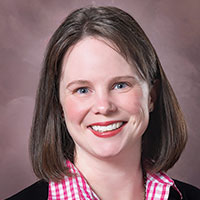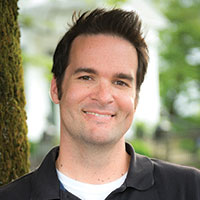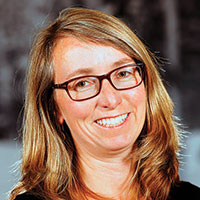Planning July 2019
Office of One
What is it like to work in a really small public planning office?
By Ruck Eckdish Knack, FAICP

Illustration by John Tomac.
The phrase "small is beautiful" actually comes from a book on economics, but it's a pretty easy concept to relate to. Deep down we all know that bigger isn't always better.
Yet everywhere you look, things seem to be expanding: Bigger developments, bigger infrastructure, and price tags to match. Smaller cities are either being slowly absorbed by ever-expanding metro areas or emptying out as residents move to the metropolis in search of opportunities.
Small-town planners wear many hats
Planning offices in major cities have grown to meet the demand for services. But for many small towns and rural municipalities across the U.S., less still means more. For the planners who work there, that means wearing a lot of hats. And many of them wouldn't have it any other way.
We talked to a few about what it's like to work in small, mostly one-person, planning offices across the country. Here's what they have to say.

Erin Chambers, AICP
Director of Community Development, Newton, Iowa (pop. 15,000)
How did you wind up where you are now?
I am back where I started. I'm originally from Iowa and so I took the job in Newton, about 35 miles from downtown Des Moines, to be able to move back to my home state. I have a BA in communications and a master's degree in urban and regional planning from the University of Iowa. Before I came here, I was a planner for Groton, Connecticut. Thirteen years ago I was hired as a city planner in Newton.
About six years after I arrived, the city underwent a restructuring and I was named director of a new department — Planning and Zoning.
Then, late last year, we were renamed again — Community Development — and my job changed once more. I no longer oversee nuisance enforcement. My department (really just me) now provides staff support for six city boards and commissions: Planning and Zoning, Zoning Board of Adjustment, Historic Preservation, the Building Trades Board, the downtown grant program, and SSMID (Self-Supporting Municipal Improvement District).
What are the big issues locally?
There are two. When I started, Newton was more or less a company town. It was the manufacturing headquarters of Maytag appliances. The year I came, Whirlpool bought the company and announced that it would close. About 2,000 employees were let go. Now we are working to diversify our economy and continue to fill the Maytag facilities.
The second big issue is housing. The city is trying hard to get developers to invest. Several projects are now under way, including transforming the historic Maytag headquarters and hotel on the central square into apartments. The city also has a program to encourage building owners to create second-story housing.
What have you learned as a solo planner?
I have learned to prioritize, to make sure everything my department works on relates to the community's goals and vision. I've also learned how important it is to work well with organizations. And I've discovered how much fun it is face a variety of tasks — as I do here in Newton. I have a truly interesting workday. I never feel that what I do is mundane. Being a planner in a small department is exciting.

John Taylor Jr.
Planning Director, Kiawah Island, South Carolina (pop. 1,600)
What route did you take to planning?
I'm from Wadmalaw Island, which is less than 20 miles from Charleston. I graduated in architecture from Florida A&M and spent two years teaching in Columbia, South Carolina, as part of City Year AmeriCorps. Then I went back to graduate school in city and regional planning at Clemson. I worked two years doing planning for Kiawah in the Charleston County planning department. I came here last July as the island's first full-time planner. Besides long-range planning, I have responsibilities in community development for zoning review, subdivision administration, and emergency management. I'm often called upon to help facilitate development matters between various groups.
Kiawah is famous for its golf resort, which hosted the PGA in 2012 and is scheduled to do so again in 2021. And its wide beach draws huge crowds. The beach area is now being redeveloped.
All those jobs...aren't you overloaded?
It depends on the time of year. During peak season when the population can swell to over 10,000, the answer is yes. The benefit for me in having all these responsibilities is that I don't do the same thing every day. Most of Kiawah Island is within a private gated community where most infrastructure and services are governed by the community association.
What is keeping you busy now?
The biggest thing is growth on parts of the island that have never been developed. My role is to work with residents and developers to make sure that the proposals are consistent with Kiawah's vision and do not have a negative effect on the community. We have monthly meetings with the development and design teams to prepare for the permitting process.

Kevin Cronin, AICP
Assistant City Manager and Development Director, Warrenton, Oregon (pop. 5,500)
How did you wind up where you are now?
I'm from Pennsylvania and got a degree in communications from Penn State. After graduation, I joined AmeriCorps. I ended up fighting wildfires in Maryland. But then I fell in love with the Pacific Northwest and in 1996 made my way to Oregon, where I got my planning degree. I worked in Portland, then became community development director in Astoria. For the past year in Warrenton, I have been the assistant city manager and development director — and the sole planner.
What are you working on?
The big things are cleaning up nuisance properties and doing a housing needs assessment and an inventory of buildable lands. I'm also beginning to create an economic development plan based on private-sector entrepreneurialism. As a coastal town, we need to take advantage of the global market. And we need to know the needs of the businesses that are here and to bring in new ones.
How do you rate your experience?
I have found this to be my best planning experience so far. Because of the community and the great team I work with. The city allows the staff to do some great things.

Sara Copeland, AICP
Community Development Director, North Kansas City, Missouri (pop. 4,300)
What was your trajectory?
I grew up in a small town in southwest Missouri, and I went to MIT as an undergraduate. I started out considering engineering but ended up in planning. After grad school, I went back to Missouri. My first job was in Olathe, Kansas (10 to 12 planners), then Granville. Missouri (staff of two); and now North Kansas City, where I am the only planner and the first in this town. It was very exciting when I got to hire my first intern.
What's happening in North Kansas City?
North Kansas City was founded in 1912 as an industrial suburb immediately across the Missouri River from downtown Kansas City. The big meat-packers were here — Armour and Swift — along with the Burlington Railroad. The town is landlocked, and development is primarily industrial buildings.
There's a lot of redevelopment going on. We have spent about 20 years acquiring and demolishing property in one part of town where there used to be two large grain mills. We're putting in new infrastructure as part of our effort to convert the old industrial buildings — including a Superfund site — into new residential complexes, hotels, and retail. We've been doing this for about six years, starting in the middle of the last recession. One goal in our master plan is to double our population.
A major issue here is changing from our traditional, Euclidean zoning to form-based codes. It's not especially controversial but does involve some significant changes — not always easy with such a small staff. We have been working on this with a local planning firm for over a year.
What has surprised you about being a solo planner?
One thing is that everyone involves me in their projects. Missouri just adopted medical marijuana, and all of our departments — including police and fire — worked together on the zoning and municipal code amendments.

Tina Crawford, AICP
City Planner, Wasilla, Alaska (pop. 10,100)
Alaska or bust?
I was working in Florida when my husband and I took a vacation trip to Alaska in 2010. We decided that's where we wanted to be. When a job came up in Wasilla, I went for it. I liked the idea of being in a small community ... and of being the sole planner.
What is Wasilla like?
It's a place where people don't like to be told what to do with their land. But as we become more urban, we tend to accept more regulations. Historically, Wasilla was just a train stop, so we don't have a lot of historic buildings. But Wasilla is the commercial heart of the Matanuska-Susitna Borough, and it is growing rapidly. I got the downtown overlay plan adopted and am working on updating the comprehensive plan. Also, right now we are redoing our regulations for short-term rentals. Our next big thing will be updating our sign code to deal with LED signs.
I know it's a lot for one person — but I love it.
What has all this taught you?
I have learned how to get plans adopted — a major accomplishment. Now I am working on expanding our electrical transmission lines without destroying our scenic views.

George Larger
Planning and Zoning Administrator, Maysville, Kentucky (pop. 9,000)
Were you always a planner?
Actually, this is my second career. My first was as a mechanical engineer. I worked in aviation for four years. I decided I wanted to be a land-use planner when I was walking down a street in my hometown, a suburb of Columbus, Ohio. There were no sidewalks. I wanted a job where I could do something about things like that. So I enrolled in the planning program at The Ohio State University, where I got my master's degree in 2015.
I wanted to plan for a small town because I knew that I would be doing different stuff. This is my first planning job, although I interned with the state while getting my master's. I started in May 2016. I do planning and zoning for Mason County and Maysville (both are under the jurisdiction of the Mason County Joint Planning Commission). There are just two other employees.
What challenges does Maysville face?
The local economy was once based on tobacco. But no more. An entire section of the town is devoted to tobacco warehouses, and the community has struggled to find suitable uses for all of them. Also, two big coal plants have closed nearby. We're working on bringing in new industry, and we've had some success.
With Mitsubishi as our largest industrial employer, we have begun to fill industrial parks, and we continue to attract big-box chains and other amenities a city of our size would not normally have. Energy companies are starting to take an interest in locating solar farms on our fallow farmland, prompting us to start regulating solar facilities in the zoning code.
What have you learned from being a solo planner?
I wear a lot of hats. This job has also turned me into an extrovert because I interact with all sorts of people on a daily basis.

Michelle Haynes, AICP
Planning and Development Services Director, Mountain Village, Colorado (pop. 1,500)
What brought you to Colorado?
I grew up in Seattle, but I went east to college — to Smith, where I majored in art history. My first job was as a ranger in Rocky Mountain National Park. At different times, I worked for Ouray County, Telluride, and the town of Mountain Village. In 2014, I got a master's in public administration. In 2017, I became the planning and development services director for Mountain Village. I manage development applications and long-range planning. Besides me, the department includes a planner and a senior planner.
What are you working on now?
A "vibrancy plan" for our village center. We are looking for ways to draw people by creating activity pods and diversifying our commercial spaces. I am also working on constructing 49 workforce housing rental units.
What are the pros of working in a very small community?
You get to do everything. And you see the people you serve all the time. I love working in a small community because change can be effected so quickly.

Keith Marvin, AICP
President of Marvin Planning Consultants, David City, Nebraska (pop. 2,900)
How did you get to David City?
I'm in David City (about an hour from Lincoln and an hour from Omaha) at least in part because this is where my wife is from. I majored in architecture at the University of Nebraska and have a master's degree in community and regional planning. For 30 years, I worked for a large engineering firm, but in 2009, I started my own consulting company, acting as planning staff for towns of all sizes throughout the U.S. My smallest client is a tiny town of 46 people. I typically have about 10 to 15 clients at a time.
Can you describe the places you work for?
Most of them don't have a planner in place. If they are lucky, they have a part-time zoning administrator. So I do a lot of comprehensive plans and zoning codes for small towns and rural counties. I also work with the communities on various studies: annexation, blight, and substandard studies for redevelopment projects. I just updated a comprehensive plan in Humphrey, Nebraska, a town of about 1,000 that sits between two regional markets, Columbus and Norfolk, and is beginning to see some growth. It has never had a plan, but it decided it was at a point where it needed help looking toward the future.
What problems do your clients face?
In rural counties like the ones I work with in Nebraska, the big issue is regulating livestock. A lot of places want to allow CAFOs — confined animal feeding operations. They raise many zoning questions both because of their size and the environmental problems associated with them. Another big issue in Nebraska is flooding and the need to come up with new flood maps and rules.
What has your job taught you?
I've learned to use my time effectively. That's needed because mine is truly a one-person shop. No secretary, no assistant.
Ruth Knack is a former executive editor of Planning.
Tips for Solo Planners
Reach out to planners in other small departments in your area. It's good to bounce ideas off someone else.
—Sara Copeland
Take on the challenge of multitasking. It's the best way to become a well-rounded planner. And work closely with your legal department on codes and regulations. Make connections with other departments: public works, transportation, engineering. You can learn from each other.
—Tina Crawford
Don't take yourself too seriously. Know when to step away. But keep your eyes on the prize: accomplishing your town's goals.
—Kevin Cronin
Build flexibility into your daily schedule. Be a team player. Find time to share ideas with other professionals. Communicate regularly with elected officials and community leaders.
—John Taylor Jr.


